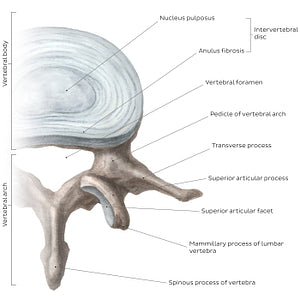Liene Znotina
Typical lumbar vertebra (English)
Typical lumbar vertebra (English)
A typical lumbar vertebra bears a large and ellipsoid vertebral body which increases in size from L1 to L5. The lumbar vertebral arches are noticeably smaller, therefore enclosing a relatively narrow vertebral canal. The spinous process is thick and short and nearly horizontally oriented. The transverse processes are more slender than those in the upper segments of the spine and are devoid of any articular surfaces. The superior processes are concave and face medially, whereas the inferior processes are convex and are laterally oriented towards the superior processes of the next vertebra. The distinguishing components of the lumbar vertebrae are the accessory and mammillary processes, which serve as the attachment sites for the deep muscles of the back; the accessory processes projects from the roots of the transverse processes (not shown), while the mammillary processes project from the posterior surfaces of the superior articular processes. The costal process is an apophysis said to be the homolog of a rib which forms the anterolateral portion of the transverse process.
Normaler Preis
$7.56 USD
Normaler Preis
Verkaufspreis
$7.56 USD
Grundpreis
pro
Verfügbarkeit für Abholungen konnte nicht geladen werden


#89776E
#4E443C
#D3E4EA und #C4B6AC

